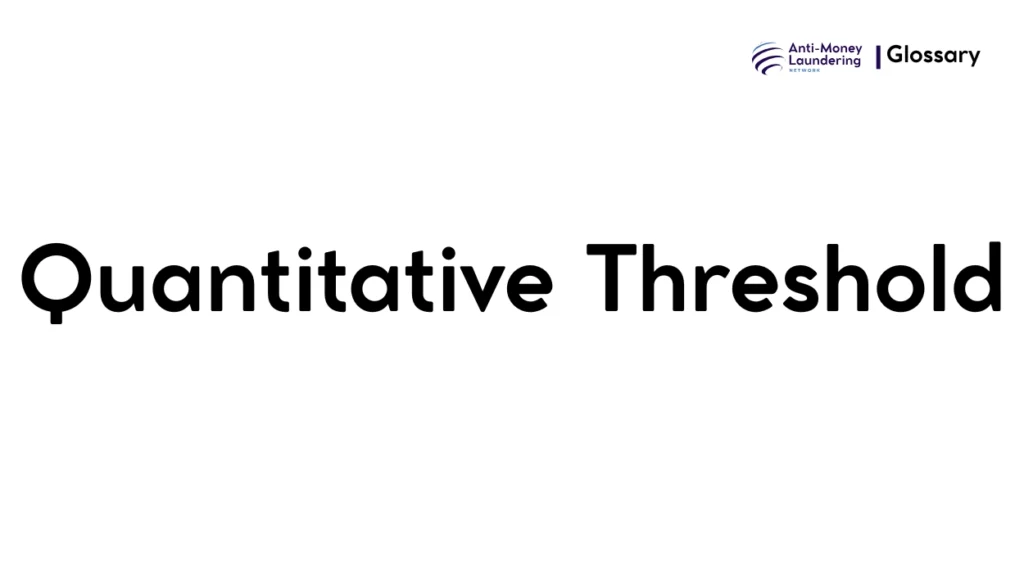Definition
In Anti-Money Laundering (AML), a Quantitative Threshold refers to a predefined monetary value or limit set by regulations or financial institutions that triggers specific AML compliance actions. These actions may include enhanced customer due diligence (CDD), transaction monitoring, suspicious activity reporting, or record-keeping requirements. The threshold serves as a critical control point that helps institutions detect potentially illicit financial activities by setting clear criteria on when closer scrutiny or reporting is mandated.
Purpose and Regulatory Basis
Quantitative thresholds are integral to AML frameworks because they establish objective monetary markers that help financial institutions manage risks related to money laundering and terrorist financing. The core purpose is to balance vigilance and operational efficiency—ensuring all transactions or activities above a certain monetary value receive appropriate AML scrutiny without overwhelming institutions with unnecessary checks on low-risk transactions.
Key global and national regulatory bases underpinning quantitative thresholds include:
- FATF Recommendations: The Financial Action Task Force (FATF) sets international AML standards, recommending the use of thresholds for transaction monitoring and reporting suspicious activities.
- USA PATRIOT Act: Mandates financial institutions to establish thresholds for identifying and reporting certain types of transactions, particularly Currency Transaction Reports (CTRs) for cash transactions over $10,000.
- EU AML Directives (AMLD): The European Union AML Directives require member states to set thresholds for customer due diligence and transaction reporting, harmonizing quantitative criteria across the EU.
- National regulations often transpose these international standards with specific numerical values adjusted for local contexts and risk profiles.
When and How it Applies
Quantitative thresholds apply in various AML compliance scenarios:
- Customer Onboarding and Due Diligence: Institutions use thresholds to decide when to apply enhanced CDD, such as verifying identities more rigorously for clients engaging in large transactions.
- Transaction Monitoring and Reporting: Transactions exceeding thresholds (e.g., $10,000 cash deposits) trigger reporting obligations to financial intelligence units (FIUs) or regulators.
- Account Activity Review: Monitoring cumulative transactions over thresholds during a specified period to detect structuring or layering attempts.
Examples:
- A bank may require enhanced verification for any single transaction over $15,000.
- A financial institution might generate a suspicious activity report (SAR) if a customer conducts multiple transactions just below the threshold amount in a pattern suggestive of money laundering.
Types or Variants
Quantitative thresholds may vary in form, depending on regulatory area and context:
- Transaction Amount Thresholds: The most common type, applying to single transactions or aggregated transactions over time.
- Customer Risk Thresholds: Certain thresholds may be lower or higher depending on customer risk categories (e.g., politically exposed persons).
- Product or Service-Specific Thresholds: Different products (e.g., wire transfers vs. cash deposits) may have distinct threshold values.
- Reporting Thresholds: These dictate the minimum amount that triggers mandatory reporting to authorities.
Procedures and Implementation
To comply with quantitative thresholds, institutions typically follow these steps:
- Policy Establishment: Develop internal AML policies embedding quantitative thresholds aligned with regulatory requirements.
- System Configuration: Implement AML software systems to automatically flag and escalate transactions exceeding thresholds.
- Staff Training: Educate frontline and compliance staff on threshold criteria and escalation procedures.
- Enhanced Due Diligence: Apply supplementary checks on flagged transactions or customers.
- Record Keeping: Maintain accurate records of transactions exceeding thresholds and related due diligence measures for regulatory inspections.
- Reporting: Timely submission of required reports (e.g., CTRs or SARs) to FIUs.
Impact on Customers/Clients
From a customer perspective, quantitative thresholds mean:
- Certain transactions or account activities demand additional verification, potentially causing delays or requests for documentation.
- Clients may face restrictions on transaction sizes or face increased scrutiny if their activity nears or exceeds thresholds regularly.
- Institutions balance customer service with regulatory compliance, ensuring transactions are not unduly impeded while maintaining AML vigilance.
Duration, Review, and Resolution
- Duration: Thresholds are applied in real-time during transaction processing and ongoing customer monitoring.
- Review: Financial institutions periodically review thresholds considering regulatory updates, market changes, and risk assessments.
- Resolution: Alerts or investigations triggered by threshold breaches are resolved through case management, including risk assessment, additional due diligence, and, if necessary, reporting or escalation.
Reporting and Compliance Duties
Institutions have key duties, including:
- Applying thresholds consistently and documenting their AML programs.
- Reporting transactions above thresholds promptly to appropriate authorities.
- Maintaining logs and audit trails for regulatory review.
- Training staff on compliance relevance and enforcement.
- Facing penalties or sanctions for failure to adhere to thresholds and reporting requirements.
Related AML Terms
Quantitative thresholds are closely linked to:
- Customer Due Diligence (CDD): Thresholds often trigger enhanced CDD measures.
- Suspicious Activity Reports (SARs): Thresholds define when a transaction may require reporting.
- Currency Transaction Reports (CTRs): A specific form of reporting linked to cash transaction thresholds.
- Risk-Based Approach: Thresholds are applied within broader risk management strategies.
Challenges and Best Practices
Common challenges include:
- Setting thresholds too low or too high, impacting operational burden or risk exposure.
- Balancing compliance with smooth customer experience.
- Adjusting thresholds in dynamic risk environments or across jurisdictions.
Best practices recommend:
- Aligning thresholds with risk assessments and regulatory changes.
- Leveraging technology for automated transaction monitoring.
- Regularly training staff and auditing threshold application.
Recent Developments
Emerging trends in quantitative thresholds include:
- Increased use of AI and machine learning to adjust thresholds dynamically based on customer behavior and emerging risks.
- Enhanced regulatory scrutiny of threshold settings and their effectiveness.
- Regional harmonization efforts in threshold standards for cross-border financial flows.
The Quantitative Threshold is a fundamental AML concept defining clear monetary limits that trigger vital compliance actions. It balances effective detection of illicit activity with operational efficiency and customer experience. Rooted in global and national AML regulations, its correct implementation underpins robust financial crime prevention frameworks and institutional compliance.

